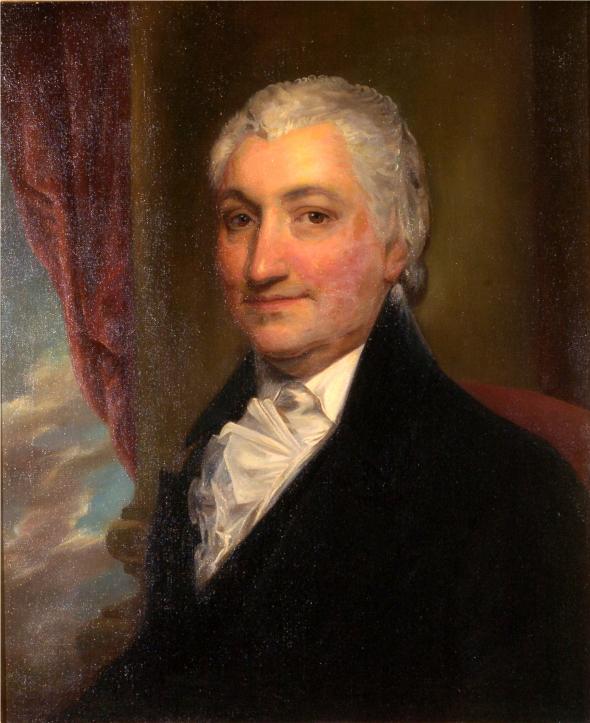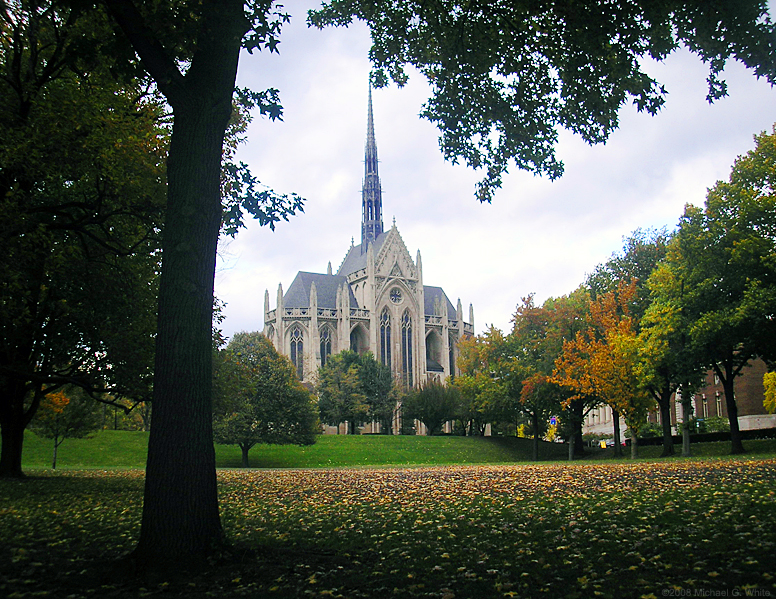|
Stephen Foster Memorial
The Stephen Collins Foster Memorial is a performing arts center and museum which houses the Stephen Foster Archives at the University of Pittsburgh in Pittsburgh, Pennsylvania, USA. It is dedicated to the life and works of American songwriter Stephen Foster. It is a contributing property to the Schenley Farms National Historic District, is designated as a Pittsburgh History and Landmarks Foundation Historical Landmark, and is a landmark whose significance is designated by a Pennsylvania Historical and Museum Commission Historical Marker. It is located along Forbes Avenue in the Oakland neighborhood on the campus of the University of Pittsburgh, often referred to as Pitt. The main structure houses the two theaters that serve as performance spaces for the university's Department of Theatre Arts: the 478-seat Charity Randall Theatre and 151-seat Henry Heymann Theatre. The left wing of the building houses the Stephen Foster Memorial Museum and the Center for American Music whic ... [...More Info...] [...Related Items...] OR: [Wikipedia] [Google] [Baidu] |
University Of Pittsburgh
The University of Pittsburgh (Pitt) is a public state-related research university in Pittsburgh, Pennsylvania. The university is composed of 17 undergraduate and graduate schools and colleges at its urban Pittsburgh campus, home to the university's central administration and around 28,000 undergraduate and graduate students. The 132-acre Pittsburgh campus includes various historic buildings that are part of the Schenley Farms Historic District, most notably its 42-story Gothic revival centerpiece, the Cathedral of Learning. Pitt is a member of the Association of American Universities and is classified among "R1: Doctoral Universities – Very high research activity". It is the second-largest non-government employer in the Pittsburgh metropolitan area. Pitt traces its roots to the Pittsburgh Academy founded by Hugh Henry Brackenridge in 1787. While the city was still on the edge of the American frontier at the time, Pittsburgh's rapid growth meant that a proper university was so ... [...More Info...] [...Related Items...] OR: [Wikipedia] [Google] [Baidu] |
Oakland (Pittsburgh)
Oakland is the academic and healthcare center of Pittsburgh and one of the city's major cultural centers. The neighborhood is home to three universities, museums, and hospitals, as well as an abundance of shopping, restaurants, and recreational activities. Oakland is home to the Schenley Farms National Historic District which encompasses two city designated historic districts: the mostly residential Schenley Farms Historic District and the predominantly institutional Oakland Civic Center Historic District. It is also home to the locally designated Oakland Square Historic District. The Pittsburgh Bureau of Fire has Fire Station No. 14 on McKee Place and Fire Station No. 10 on Allequippa Street in Oakland. Neighborhoods Oakland is officially divided into four neighborhoods: North Oakland, West Oakland, Central Oakland, and South Oakland. Each section has a unique identity, and offers its own flavor of venues and housing. Oakland is Pittsburgh's second most populated neighborhoo ... [...More Info...] [...Related Items...] OR: [Wikipedia] [Google] [Baidu] |
Josiah K
Josiah ( or ) or Yoshiyahu; la, Iosias was the 16th king of Judah (–609 BCE) who, according to the Hebrew Bible, instituted major religious reforms by removing official worship of gods other than Yahweh. Josiah is credited by most biblical scholars with having established or compiled important Hebrew scriptures during the "Deuteronomic reform" which probably occurred during his rule. Josiah became king of the Kingdom of Judah at the age of eight, after the assassination of his father, King Amon. Josiah reigned for 31 years, from 641/640 to 610/609 BCE. Josiah is known only from biblical texts; no reference to him exists in other surviving texts of the period from Egypt or Babylon, and no clear archaeological evidence, such as inscriptions bearing his name, has ever been found. Nevertheless, most scholars believe that he existed historically and that the absence of documents is due to few documents of any sort surviving from this period, and to Jerusalem having been occupied, ... [...More Info...] [...Related Items...] OR: [Wikipedia] [Google] [Baidu] |
Short Ton
The short ton (symbol tn) is a measurement unit equal to . It is commonly used in the United States, where it is known simply as a ton, although the term is ambiguous, the single word being variously used for short, long, and metric ton. The various tons are defined as units of mass.Butcher, Crown and Gentry, NIST Special Publication 1038, The International System of Units (SI) – Conversion Factors for General Use, 2006 They are sometimes used as units of weight, the force exerted by a mass at standard gravity (e.g., short ton-force). One short ton exerts a weight at one standard gravity of 2,000 pound-force (lbf). United States In the United States, a short ton is usually known simply as a "ton", without distinguishing it from the tonne (), known there as the "metric ton", or the long ton also known as the "imperial ton" (). There are, however, some U.S. applications where unspecified ''tons'' normally mean long tons (for example, naval ships) or metric tons (world grain ... [...More Info...] [...Related Items...] OR: [Wikipedia] [Google] [Baidu] |
Gothic Revival Architecture
Gothic Revival (also referred to as Victorian Gothic, neo-Gothic, or Gothick) is an architectural movement that began in the late 1740s in England. The movement gained momentum and expanded in the first half of the 19th century, as increasingly serious and learned admirers of the neo-Gothic styles sought to revive medieval Gothic architecture, intending to complement or even supersede the neoclassical styles prevalent at the time. Gothic Revival draws upon features of medieval examples, including decorative patterns, finials, lancet windows, and hood moulds. By the middle of the 19th century, Gothic had become the preeminent architectural style in the Western world, only to fall out of fashion in the 1880s and early 1890s. The Gothic Revival movement's roots are intertwined with philosophical movements associated with Catholicism and a re-awakening of high church or Anglo-Catholic belief concerned by the growth of religious nonconformism. Ultimately, the "Anglo-Catholicism" t ... [...More Info...] [...Related Items...] OR: [Wikipedia] [Google] [Baidu] |
Heinz Memorial Chapel
Heinz Memorial Chapel is a Pittsburgh History and Landmarks Foundation Historic Landmark and a contributing property to the Schenley Farms National Historic District on the campus of the University of Pittsburgh in Pittsburgh, Pennsylvania, United States. History The chapel was a gift of German-American Henry John Heinz, founder of the H.J. Heinz Company, who wanted to honor his mother, Anna Margaretha Heinz, with a building at the university. Upon his death in 1919, Heinz's three surviving children (Howard, Irene, and Clifford) added to his bequest in order to memorialize their grandmother and honor their father. Their choice of a chapel for a memorial was guided by the concepts of education and religion which Anna Margaretta Heinz imbued in her children. Howard Heinz, Chancellor John Gabbert Bowman, and Joh Weber, business manager and university secretary, were the driving energy behind the chapel's concept and execution. Working with them were other members of the Heinz ... [...More Info...] [...Related Items...] OR: [Wikipedia] [Google] [Baidu] |
Cathedral Of Learning
The Cathedral of Learning is a 42-story skyscraper that serves as the centerpiece of the University of Pittsburgh's (Pitt) main campus in the Oakland neighborhood of Pittsburgh, Pennsylvania. Standing at , the 42-story Late Gothic Revival Cathedral is the tallest educational building in the Western Hemisphere and the second-tallest university building (fifth- tallest educationally-purposed building) in the world, after the main building of Moscow State University. It is also the second-tallest gothic-styled building in the world, after the Woolworth Building in Manhattan. The Cathedral of Learning was commissioned in 1921 and ground was broken in 1926 under general contractor Stone & Webster. The first class was held in the building in 1931 and its exterior finished in October 1934, prior to its formal dedication in June 1937. It is a Pittsburgh landmark listed in the National Register of Historic Places. Colloquially referred to as "Cathy" by Pitt students, the Cathedral of L ... [...More Info...] [...Related Items...] OR: [Wikipedia] [Google] [Baidu] |
Indiana Limestone
Indiana limestone — also known as Bedford limestone in the building trade — has long been an economically important building material, particularly for monumental public structures. Indiana limestone is a more common term for Salem Limestone, a geological formation primarily quarried in south central Indiana, USA, between the cities of Bloomington and Bedford. It has been called the best quarried limestone in the United States. Indiana limestone, like all limestone, is a rock primarily formed of calcium carbonate. It was deposited over millions of years as marine fossils decomposed at the bottom of a shallow inland sea which covered most of the present-day Midwestern United States during the Mississippian Period. History Native Americans were the first people to discover limestone in Indiana. Not long after they arrived, American settlers used this rock around their windows and doors and for memorials around the towns. The first quarry was started in 1827, and by 1929 ... [...More Info...] [...Related Items...] OR: [Wikipedia] [Google] [Baidu] |





